69 Search Results for magic moments
January 16, 2017
by Carole Zangari -
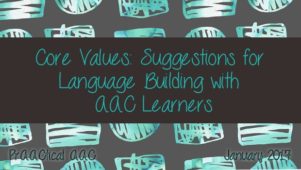
Here in the US, we celebrate the life of Dr. Martin Luther King Jr on the third Monday of January. It presents, among other things, a wonderful opportunity to talk and teach about concepts like tolerance, fairness, dignity, respect, and peaceful protest. Many of our AAC learners have a deeper understanding of these concepts than we will ever realize but they lack the language skills to discuss them in the same ways as their speaking peers do. Today, we share some ideas for continuing the conversation about these issues to help our AAC learners continue to develop their language skills. You may already have books, videos, and other resources that are useful in teaching about the life of Dr. King and the values he fought for, but here are some previous posts with a few more suggestions. Martin Luther King, Jr Holiday: 5 Resources for AAC Learners AAC and Anti-bullying... [Read More...]
March 28, 2016
by Carole Zangari -
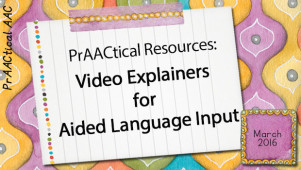
A growing number of clinicians, families, and educational teams are prioritizing the use of aided language input as a foundational strategy for AAC learners. When we first started writing about this strategy, it was rare to see adults using AAC to talk with AAC learners.Consistent implementation is still a challenge, but more and more of you are speaking AAC to teach AAC. And quite of few of you are doing your best to influence other stakeholders to support augmented communicators in this way. If you are doing inservices, teaching classes, or guiding teams toward better AAC intervention, the videos listed below may be useful to you in those efforts. Chris Bugaj developed this clear and engaging cartoon explaining the concept for people new to this strategy. Caroline Musselwhite recorded a full webinar with detailed information on aided language input. Communicare, a clinical practice with a strong focus on AAC,... [Read More...]
October 27, 2015
by Carole Zangari -
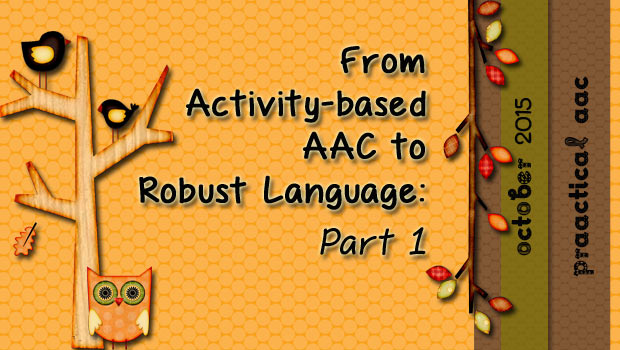
As far as I can tell, most AAC learners are taught by people who don’t specialize in AAC. Their school SLPs may have caseloads of 50, 60, 70, or more students with IEPs, 90% of whom have goals for articulation, language, and fluency. Their classroom teachers serve students whose disabilities range from none at all, to dyslexia to cerebral palsy, to significant intellectual disabilities, and everywhere in between. In all likelihood, neither group had much AAC training. What little AAC they know, they’ve picked up on their own from reading, going to workshops and conferences (usually self-funded), talking to colleagues, and exploring online resources. Many times, their first foray into AAC is with things like choice boards and visual supports, such as daily schedules and first/then boards. From there, they may begin labeling the environment with pictures symbols (e.g., ‘table’ on the table, ‘on/off’ near the light switch), using mini-schedules... [Read More...]
July 13, 2015
by Carole Zangari -
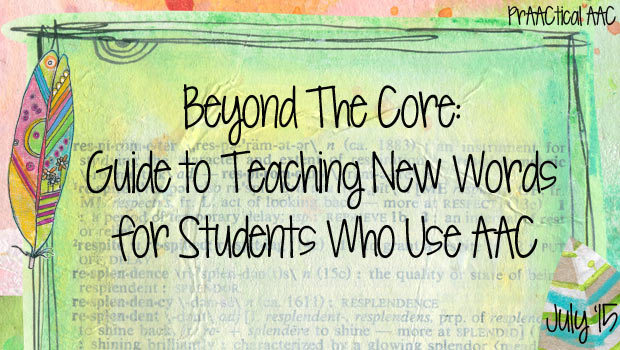
Teaching AAC learners to expand their vocabularies beyond a basic set of core words is an important goal to target in language development, and a topic that we’ve written a lot about in this space. For the student to be successful, SLPs need to think of vocabulary instruction as an ongoing process that has a clear 3-part structure. Introduction: Word is used in context, defined, and produced by the learner. Students assess their own knowledge of the word. Explicit Instruction: Activities are created to help the student really understand what the word means and how to use it. Students begin using it throughout the session. Continued Practice: We continue to use these words and help the student use the target words in the session. Engaging activities, often with technology, are used to help our learners deepen their understanding of the word. This will be accomplished over multiple sessions. In this... [Read More...]
April 21, 2015
by Carole Zangari -
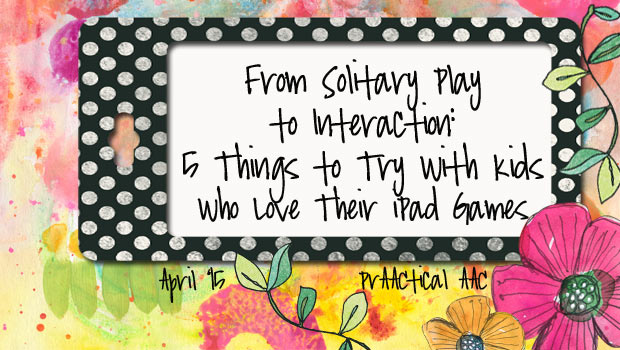
“But my kid wants to use the app on his own terms, not with ME!” Ever faced this conundrum? There are so many wonderful apps that are terrific for building interaction and language skills, but some of our prAACtical friends don’t want us to interact with them during iPad play**. Today, we’re thinking about strategies to use when kids would rather engage in solitary play as opposed to welcoming us as interaction partners in their iPad games. How can we help them increase their tolerance for interaction when playing on the iPad? Here are a few things to try. Make expectations clear with visual supports. It’s hard to cooperate when you don’t have an understanding of what’s supposed to happen. When kids are used to playing games, reading books, or watching videos on their own, they sometimes resist our participation out of the fear that they won’t get to do... [Read More...]
September 4, 2014
by Carole Zangari -
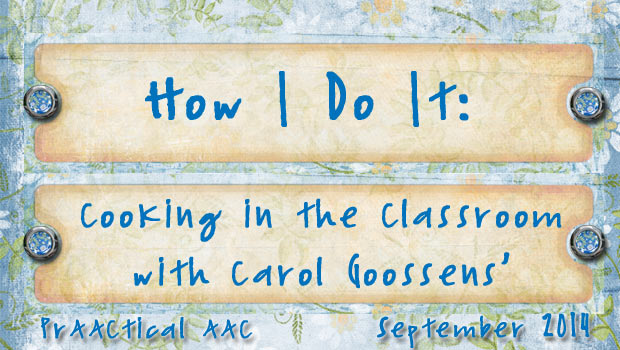
There is something about fall that puts us in the mood for cooking. Today, we are honored to learn from an AAC pioneer, Dr. Carol Goossens,’ who is an SLP and special educator based in the New York City area. She has consulted extensively in a variety of classrooms serving the full spectrum of children with special needs. Carol has presented both nationally and internationally about her collaborative work with teachers, therapists and families. She is known for her ability to seamlessly integrate technology in the classroom and for developing innovative ways to help children learn …while having fun doing it! In this post, she shares one of her latest projects, making animated recipes for using in cooking activities in the classroom. Cooking appears to be motivating for most children … the magic of putting together ingredients that ultimately become something delicious to eat. Teachers, speech-language pathologists (SLPs) and occupational therapists (OTs) often use food preparation activities... [Read More...]
March 14, 2014
by Carole Zangari -
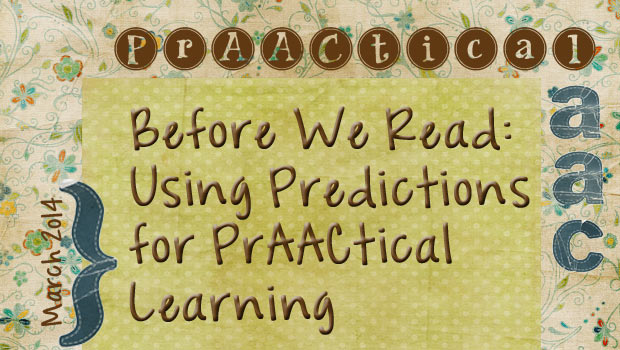
This month, we’re focusing on literacy learning for our Monday posts on Strategy of the Month. In honor of that topic, here’s a quick tip for adding a bit of interaction to book reading. This tip works for books you’ve never read before, or perhaps haven’t read in a really long time. Take a few minutes before the reading begins to predict what the book will be about. We’ll get to the ‘How To’ part in a minute, but first, here’s why we think this is a prAACtical idea. It gets AAC learners thinking about something more than requesting, and we know you are just as passionate about that as we are. It helps the AAC learner activate their background knowledge, something that (we’ve noticed) many of them don’t do automatically. That doesn’t mean that they aren’t capable of it, of course, but it does mean they need practice and... [Read More...]
March 28, 2013
by Carole Zangari -
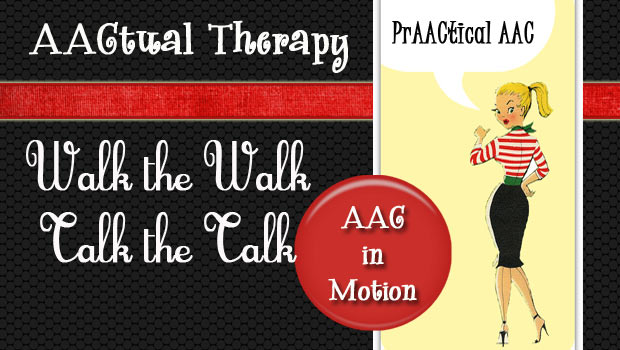
Tanna Neufeld hits another homerun with this post about co-treating children with multiple disabilities. Collaborating with our colleagues is both fun and challenging. Let’s take a look at the prAACtical ways that Tanna and her colleagues support kids with motor and visual impairments who are learning to use AAC. Fridays are my favorite. And not just for the obvious reasons (TGIF), but also because Fridays are one of the most challenging and exciting days of my work week. Every Friday, I am lucky enough to team with my favorite PTs for joint treatment sessions to support several children with multiple motor and communication challenges. Around our center, we lovingly refer to these kids as our “motor kids”. All of these little ones are nonverbal, and all have very complex motor challenges that significantly limit their ability to interact with traditional play and learning environments. Many of these kids also... [Read More...]
February 14, 2013
by Carole Zangari -
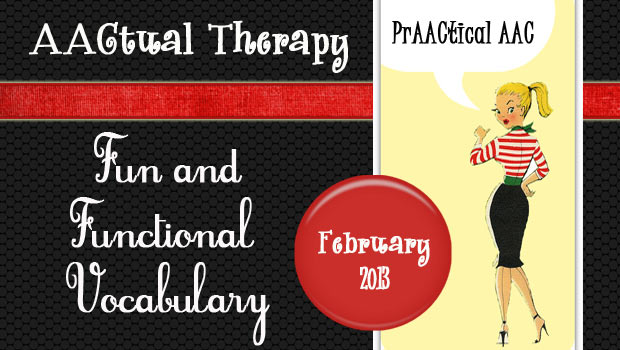
We are delighted to have Shareka Bentham back to share another post about the AACtual therapy she provides to little ones in Barbados. Last month, we followed her along to the zoo where her little friends got to generalize the language skills developed in therapy sessions. In this post, Shareka discusses her approach to something we all struggle with: selecting vocabulary that will both fun and functional. One of my biggest challenges in AAC is choosing good vocabulary targets, and working on vocabulary instruction for early communicators. By ‘good’ I mean targets which are functional for their everyday settings, representative, and most of all fun for children who are not only beginning communicators, but also beginning AAC users. I have become the AAC ‘specialist’ at a school for children with complex communication needs, so I generally have to cater to the communicative needs of children from the pre-communication to... [Read More...]








